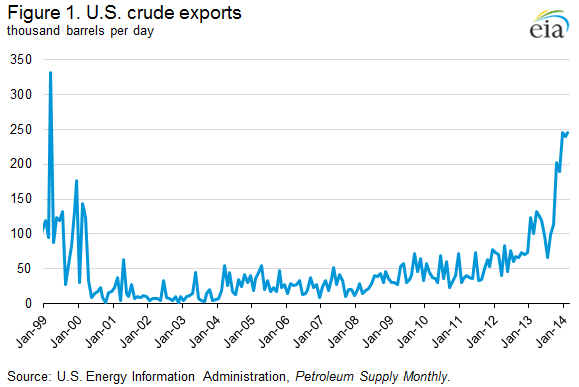The U.S. Energy Information Association reports today crude oil exports from the U.S. reached 246,000 barrels per day (bbl/d) of crude oil in March 2014 representing the highest level of exports in 15 years. This growth is primarily due to rising crude oil production which is at its highest levels since at least 1989.
The U.S. was producing 8.0 million bbls/day in February 2014.

How U.S. Crude is Exported
To export crude oil from the United States, a company must obtain a license from the Bureau of Industry and Security (BIS) of the U.S. Department of Commerce. Pursuant to Section 754.2 of the BIS export Administration Regulations which codifies the export licensing requirements, the following kinds of transactions will generally be approved:
- Exports from Alaska’s Cook Inlet;
- Exports to Canada for consumption or use therein;
- Exports in connection with the refining or exchange of strategic petroleum reserve oil;
- Exports that are consistent with international energy supply agreements;
- Exports of foreign-origin crude;
- Exports of California Heavy crude up to an average of 25,000 bbl/d;
- Temporary exports or exchanges
Licenses for other exports of U.S.-origin crude are considered on a case-by-case basis. For such other exports, the regulations describe the characteristics of transactions that will generally be approved as in the national interest.
Almost all of the crude oil exported from the United States has been delivered to Canada, and most of the recent increase in crude oil exports has been from the U.S. Gulf Coast (PADD 3) (Figure 2).
Gulf Coast crude exports averaged 134,000 bbl/d in the first quarter of 2014, a 283% increase over 2013’s record high of 35,000 bbl/d. In the first quarter 2014, nearly 75% of Gulf Coast exports have left the region from the Houston-Galveston district, in Texas. The remaining barrels were loaded in Port Arthur, Texas and New Orleans, Louisiana.
Exports from the East Coast (PADD 1) averaged 30,000 bbl/d in the first quarter of 2014, down slightly from 2013 levels, but up from 9,000 bbl/d in 2012. First quarter exports from PADD 1 were evenly distributed between the Port of New York and Portland, Maine, which is the starting point of a pipeline that delivers crude to refineries in the Montreal area.
Exports of crude from the Midwest (PADD 2) have long been a source of crude for refineries in Sarnia, Ontario.

In the last several years, exports to countries other than Canada have been rare. Such shipments have been limited to re-exports of foreign-origin crude oil, initially intended for processing by U.S. refineries. Foreign-origin crude has been re-exported to China, Costa Rica, France, South Korea, and Mexico.
More recently, trade press has reported that a cargo of Canadian crude oil loaded in the Gulf Coast for delivery to a refinery in Spain.
With limited infrastructure available to transport growing Canadian crude production to the country’s coasts where it could be delivered into the global market, producers are looking for other ways to reach such markets. The estimated 500,000-600,000 bbl of Canadian crude was said to have been loaded with 500,000 bbl of Mexican Maya in early May. The Canadian barrels were transported via rail to the Gulf Coast to clearly satisfy the requirement that foreign barrels are not commingled with crude of U.S. origin.
Although this is the first reported shipment of its kind, it could be a harbinger of other rail-to-tanker movements. Pipeline-to-tanker movements could also occur in the future if provisions can be made to satisfy the requirement that foreign oil that is destined for export markets has not been commingled with oil of U.S. origin.
via EIA.gov

 Join The Club
Join The Club












